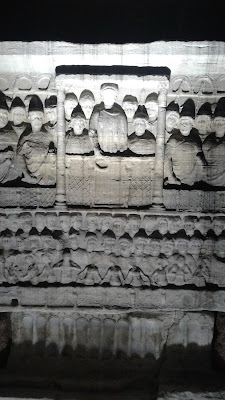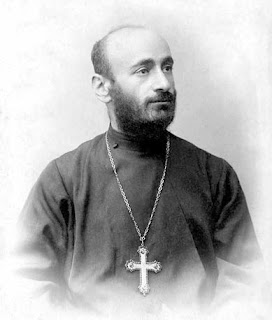Hippodrome, Constantinopolis (200 AD - 1453 AD)
There was an ancient Greek style stadium here where
nothing much remains now. That stadium was called the Hippodrome of
Constantinopolis. Hippodrome, dromos meaning street and hippos horses, thus the
street of the horses was a place where horse and chariot racing were done. It
is usually built on a slope, in this case between the first and second hills of
Istanbul. The downward side is filled to make an embankment to level the
ground. That semicircular embankment facing the Marmara Sea is called Sphendon.
It still survives today with its arches.
The other end is the entrance. It is a porch with a
colonnade on top of the entrance four bronze horses valiantly stood. The four
horses of a chariot… They were taken away to Venice during the Fourth Crusade
when the Latins under the leadership of old Enrico Dandolo whom was blinded by
the Byzantines invaded and plundered Constantinople. That was a severe
punishment by the Venetians against atrocities committed to her colony in
Constantinople years before.
The Hippodrome of Constantinople was actually a Roman
circus, built to a Roman design which is natural. It was built during two to
three hundreds. In the western sphere there was turmoil, the cohesion of the
empire dissolved in mass movements of tribes within its borders and defeats of
its army. Rome was about to collapse. Constantine looked for a defendable place
for a new capital. He would make his stand in Byzantium a mediocre city in the
east. He would call it Nova Roma (New Rome), he meant to make it feel like
Rome. He went into a building spree, built the Great Palace and renovated the
Hippodrome.
 |
| Theodosius at Kathisma, Emperor's Lodge Source: Ahmet Abbasoğlu, June 10, 2016 |
So the administrative center sat close to the entertainment arena and religious center Hagia Eirene and Hagia Sophia. Three sources of power all together side by side... From the palace the Emperor can directly go to his private lodge Kathisma in the tribune. One can see scenes from the tribune on the base of the Obelisk of Thutmose III which stands on the spine of the hippodrome. The scene above is Theodosius standing in Kathisma holding a laurel wreath in his hand waiting to award it to the victor.Theodosius brought the granite obelisk from the Temple of Karnak in Luxor half way up the source of Nile. It must have been quite an exotic piece for the Romans too. When they brought it to Constantinople it was close to 1900 years old from a mysterious civilization founded on a hot climate river valley.
 |
| Obelisk of Thutmose, Hippodrome of Constantinople Source: Ahmet Abbasoğlu, June 10, 2016 |
One other obelisk adorning the spine of the racing
track is called the Walled Obelisk. It was built in the 10th century
of cut stone when the Byzantines were losing their greatness. After the 7th
century Arabs were becoming a great power at the expense of the Byzantines.
Egypt a resource of obelisks was taken by the Arabs when they just moved out of
their peninsula. Arriving the 10th century only the Balkans and
Anatolia were the major pieces of land that remained in their hands. So instead
of transporting one they decided to build one, but it was a pretty rough one
compared to the one brought from Egypt. It used to have copper plates nailed on
it but they too were removed during the plunder by the Latins.
Close to the Walled Obelisk sits the Serpent Column.
It was made to celebrate the Ancient Greek victory over the Persians (5th
century BC). The serpent heads are lost save one which is discovered and is
displayed in Istanbul Archeology Museum. Although it seems to be a mystical and
heroic piece to ornament the stadium, it also (referring to the Greek victory
over the Persians) might be a propaganda of defiance of the Persian state of
the Sasanids which they restlessly fight in the east.
 |
| The Serpent Column, 1682, Wheler, George Source: Travelogues, Aikaterini Laskaridis Foundation |
Statues of Heracles (by Lysippos) and Romulus and
Remus with their wolf must have sent the message of power, physical and
political respectively.
The hippodrome, the races served as an outlet for the
commoners and the members of the aristocracy where most channels might have
been blocked. The chariot teams were sponsored by different political parties
within the senate. Blues and Greens were the major of the four teams that
competed on the dusty tracks. Like football is not only football, chariot
racing was not only chariot racing. It must have been a place to check the
public pulse, their happiness, their dissent. Emperor and the common citizen
seeing each other face to face. When being part of a blue or green tribe makes
you forget your worries and lead you to ecstasy it also could lead you to ecstasy
in a different way than sportive victory. To political discussion, quarrel and
riot... Nika riots of 532 were a famous example of that. It took its name
because of the “Nika!” chants of the supporters which means victory in Greek.
After the riot had destructed the city even the prime church Hagia Sophia it
ended in a bloody fashion. The rioters were split up into the two factions they
come from by political maneuver and greens were slaughtered. Who knows maybe
it’s a shrewd plan to see your enemies gather under a green flag and destroy
them totally.


Regarding the serpent column; Do you think the original could be taken to a museum and a replica of the original form, I mean with the serpent heads, could be placed instead? One thinks of David in Florence. The original David is in the academy while there is a replica in the town square. Or the replica of the full form with the serpent heads could be installed somewhere nearby in the city. I believe it would be an impressive monument
ReplyDeleteI think that's a nice idea, keeping the original within the Archeology museum with the single serpent head there and replacing it with a replica.
ReplyDeleteThere are lots of restorations going around the city not all of them with success. At least this one would look nice if done with attention to detail.